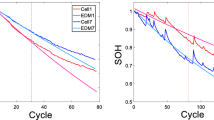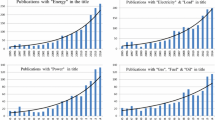Abstract
Electricity, a kind of clean energy, has been widely used in people’s production and daily life. However, it is very difficult to estimate the electricity energy production in advance and store the rest of the electric energy due to the climate, environment, population and other factors. Based on data preprocessing and artificial intelligence optimization algorithm, this paper introduces a combined forecasting method. The proposed method contains six individual methods, and each individual method has its own usage. Singular spectrum analysis (SSA) is adopted to reduce noise from the original data; three individual forecasting methods, Jordan neural network, the echo state network, least squares support vector machine, are applied to obtain the intermediate forecasting results; two optimization algorithms, particle swarm optimization and simulated annealing, are used to optimize the parameters of the combined model. This paper not only validates the superiority of the combined model compared to the single predictive model through the simulation experiments of power load data and electricity price data. The mean absolute percent error (MAPE) of the combined power load and electricity price forecast results are 1.14% and 7.58%, respectively, which are higher than the MAPE error of the corresponding single models prediction results. It has also been verified that the process of eliminating noise by the SSA plays a positive role in the accuracy of the combined forecasting model. In addition, two series of experiments on the power load data lead to two very interesting conclusions. One of the conclusions is that as the size of the test data increases, the prediction accuracy of the model decreases; the other is that the predicted result calculated through the optimized combined weight is better than the combined result calculated using the average weight, and the average weight is used. Weighted combination does not improve the prediction accuracy of a single model.






Similar content being viewed by others
References
Moghram I, Rahman S (1989) Analysis and evaluation of five short-term load forecasting techniques. IEEE Trans Power Syst 4(4):1484–1491
Ren Y, Suganthan PN, Srikanth N (2015) Ensemble methods for wind and solar power forecasting—a state-of-the-art review. Renew Sustain Energy Rev 50:82–91
Ren Y, Zhang L, Suganthan PN (2016) Ensemble classification and regression-recent developments, applications and future directions [review article]. IEEE Comput Intell Mag 11(1):41–53
Ren Y et al (2016) Random vector functional link network for short-term electricity load demand forecasting. Inf Sci Int J 367–368(C):1078–1093
Kamyab F, Bahrami S (2016) Efficient operation of energy hubs in time-of-use and dynamic pricing electricity markets. Energy 106(1):343–355
Coelho VN et al (2016) A self-adaptive evolutionary fuzzy model for load forecasting problems on smart grid environment. Appl Energy 169:567–584
Qiu X et al (2017) Empirical mode decomposition based ensemble deep learning for load demand time series forecasting. Appl Soft Comput 54(C):246–255
Karadede Y, Özdemir G, Aydemir E (2017) Breeder hybrid algorithm approach for natural gas demand forecasting model. Energy 141:1269–1284
Boroojeni KG et al (2017) A novel multi-time-scale modeling for electric power demand forecasting: from short-term to medium-term horizon. Electr Power Syst Res 142:58–73
Panapakidis IP, Dagoumas AS (2017) Day-ahead natural gas demand forecasting based on the combination of wavelet transform and ANFIS/genetic algorithm/neural network model. Energy 118:231–245
Jozefowiez N, Semet F, Talbi E (2002) Parallel and hybrid models for multi-objective optimization: application to the vehicle routing problem, pp 271–280
Ishibuchi H, Mihara S, Nojima Y (2013) Parallel distributed hybrid fuzzy GBML models with rule set migration and training data rotation. IEEE Trans Fuzzy Syst 21(2):355–368
Liu Li, Wang Shu, Bin Hu, Qiong Qingyu, Wen Junhao, Rosenblum David S (2018) Learning structures of interval-based Bayesian networks in probabilistic generative model for human complex activity recognition. Pattern Recogn 81:545–561
Liu Li, Wang Shu, Guoxin Su, Huang Zi-Gang, Liu Ming (2017) Towards complex activity recognition using a Bayesian network-based probabilistic generative framework. Pattern Recogn 68:295–309
Nojima Y, Mihara S, Ishibuchi H (2010) Parallel distributed implementation of genetics-based machine learning for fuzzy classifier design. Springer, Berlin, pp 309–318
Qiu X, Suganthan PN, Amaratunga GA (2018) Ensemble incremental learning Random Vector Functional Link network for short-term electric load forecasting. Knowl Based Syst 145:182–196
Cruse H (2006) Neural networks as cybernetic systems. Brain, minds, and media. http://www.brains-minds-media.org/archive/289. Accessed Aug 2018
Jaeger H (2004) Harnessing nonlinearity: predicting chaotic systems and saving energy in wireless communication. Science 304(5667):78–80
Szko J et al (2011) Recurrent neural networks in computer-based clinical decision support for laryngopathies: an experimental study. Comput Intell Neurosci 2011(3):252–257
Jaeger H, Haas H (2004) Harnessing nonlinearity: predicting chaotic systems and saving energy in wireless communication. Science 304(5667):78–80
Wang L, Wang Z, Liu S (2016) An effective multivariate time series classification approach using echo state network and adaptive differential evolution algorithm. Expert Syst Appl 43(C):237–249
Bianchi FM et al (2015) Prediction of telephone calls load using Echo State Network with exogenous variables. Neural Netw 71(C):204–213
Ghasemi A et al (2016) A novel hybrid algorithm for electricity price and load forecasting in smart grids with demand-side management. Appl Energy 177:40–59
Kaytez F et al (2015) Forecasting electricity consumption: a comparison of regression analysis, neural networks and least squares support vector machines. Int J Electr Power Energy Syst 67(67):431–438
Kennedy J, Eberhart R (2002) Particle swarm optimization. In: Proceedings of IEEE international conference on neural networks, 1995
Saleh B (2015) An experimental analysis of the echo state network initialization using the particle swarm optimization. In: Nature and biologically inspired computing
Kirkpatrick S, Daniel GC Jr, Vecchi MP (1983) Optimization by simulated annealing. Science 220(4598):671
Broomhead DS, King GP (1986) Extracting qualitative dynamics from experimental data. Physica D 20(2–3):217–236
Broomhead DS, King GP (1986) On the qualitative analysis of experimental dynamical systems. Nonlinear Phenom Chaos 113:144
WIKIPEDIA Web Site [Online]. Singular spectrum analysis. https://en.wikipedia.org/wiki/Singular_spectrum_analysis. Accessed Aug 2018
Suykens JAK et al (2002) Least squares support vector machines. Euphytica 2(2):1599–1604
Bates JM, Granger CWJ (2001) The combination of forecasts. Cambridge University Press, Cambridge, pp 451–468
An N et al (2013) Using multi-output feedforward neural network with empirical mode decomposition based signal filtering for electricity demand forecasting. Energy 49(1):279–288
Wang J, Xiao L, Shi J (2014) The combination forecasting of electricity price based on price spikes processing: a case study in South Australia. Abstr Appl Anal 2014(2):1–12
Acknowledgements
The authors would like to thank the Natural Science Foundation of PR of China (61073193, 61300230), the Key Science and Technology Foundation of Gansu Province (1102FKDA010), the Natural Science Foundation of Gansu Province (1107RJZA188), and the Science and Technology Support Program of Gansu Province (1104GKCA037) for supporting this research.
Author information
Authors and Affiliations
Corresponding author
Additional information
Publisher's Note
Springer Nature remains neutral with regard to jurisdictional claims in published maps and institutional affiliations.
Rights and permissions
About this article
Cite this article
Zhang, H., Yang, Y., Zhang, Y. et al. A combined model based on SSA, neural networks, and LSSVM for short-term electric load and price forecasting. Neural Comput & Applic 33, 773–788 (2021). https://doi.org/10.1007/s00521-020-05113-0
Received:
Accepted:
Published:
Issue Date:
DOI: https://doi.org/10.1007/s00521-020-05113-0




